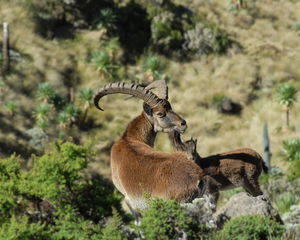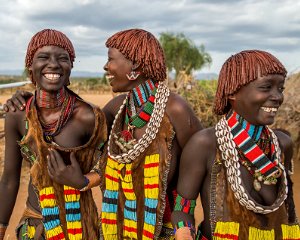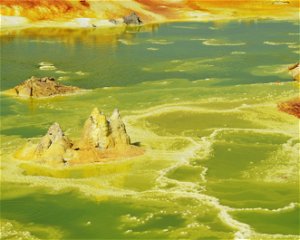Best Time To Visit Ethiopia.
The best time to visit Ethiopia typically spans from September to April. In this interval, the landscape shifts dramatically: it's usually dry and barren in April, yet by September and October, it becomes vibrant with verdant greenery. This period is also prime for spotting highland wildlife. Travel is most favorable from October to March, with reduced rainfall and gentler temperatures, especially in the far north and south of the country.
For an optimal experience, it's advisable to tour northern and central Ethiopia in the dry season, which runs from October to April. Southern Ethiopia, on the other hand, is best visited during its dry spell, from October to March, when conditions are more conducive to travel.
Northern Historic Circuit and to its Highlands
The October to February dry season is the best time to plan a trip to the ancient rock-cut churches of Ethiopia's stunning Northern Highlands. However, even during the wet season, rains rarely last all day. If you're looking to save money, consider booking a trip in March or April, when the rains are light and prices for accommodation and tours are generally lower. Usually, it's best to avoid traveling in June and July, when the rains in this region are at their most extreme. EXPLORE NORTHERN HISTORIC TOURS
Trekking to Simien Mountains National Park
The Simien Mountains are a vast mountain range whose highest peak stands at 14,872 feet, making it one of the highest mountains in Africa. Trekking here is fantastic, not only because of the scenery, gorges, and streams but also because you get a chance to look for endemic wildlife like the Gelada Baboon and the Walia Ibex. The best time to trek is from September to November, when it's dry, green, and relatively dust-free. October, in particular, can be spectacular because this is when the mountain wildflowers are in full bloom. SIMIEN TREKKING
Best time to visit Bale Park
November to February is generally considered the best time to visit Bale Mountains National Park. This is the Dry season and conditions are ideal for hiking. Traveling in the Wet season months can be a bit more of an adventure as downpours can interrupt activities. Lush vegetation, clear views and wildflowers are characteristic of this time. TREKKING IN BALE PARK
Best Time to visit the Omo Valley
The best time to visit the Omo Valley is during the dry season, which typically spans from November to March. This period offers the most comfortable weather, with cooler temperatures and less rainfall, making it easier to navigate the rugged terrain and remote villages of the region. The dry season also ensures that river crossings are more manageable, allowing for better access to remote tribal communities.
During the dry season, the Omo Valley is endowed with cultural events and ceremonies. Many tribes hold exuberant festivals which showcases their cultural traditions and offer a unique vantage point to experience these ancient customs.
It’s important to note that the Omo Valley lowlands can become excruciatingly hot during the dry season, particularly in January and February, so we highly recommend that you come fully prepared with appropriate clothing and methods to stay hydrated during your trip. TOUR TO OMO VALLEY
Best Time to Visit the Danakil Depression
Danakil is one of the hottest places on earth, with daytime temperatures easily reaching 122 degrees Fahrenheit.4 It's a fascinating destination where you can witness the age-old tradition of salt caravans, experience Afar culture, and marvel at a myriad of active volcanoes. If you've ever felt the urge to visit another planet, you'll love the extraordinary landscapes of this region. To avoid feeling like you're boiling alive, however, make sure to visit during the cooler months of November to March. ADVENTURE TOUR TO DALLOL AND ERTAL
Best Time for Experiencing Ethiopia's Festivals
Ethiopian festivals are certainly worth planning a trip around. Mostly religious, festivals generally last several days. Orthodox Christian festivals are the most prominent and visible in Ethiopia and are celebrated according to the Ethiopian calendar. For example, Ethiopian Christmas (known as Ganna) is celebrated on January 7, rather than December 25. Enkutatash, the Ethiopian New Year, is celebrated on September 11.
If you're keen to experience Ethiopian festivities at their most colorful, consider planning your trip around Meskel or Timkat, but be prepared to book your domestic flights and hotels well in advance.
Key Festivals & Events
Timkat, the Feast of Epiphany held on January 19, is Ethiopia's biggest festival, celebrating the baptism of Jesus. The festival lasts for three days, and includes a procession of the church's tabot, or consecrated replica of the Arc of the Covenant; and ritual re-enactments of the baptism. When the more solemn aspects of the festival are over, participants enjoy feasting, music, and dancing. The best places to enjoy the festival are Gondar, Lalibela, and Addis Ababa. It is worth joining a tour, just to make sure that you are able to reserve accommodation. It's also good to have a guide who can tell you exactly what is going on during the processions.
Later in the year, the country celebrates Meskel on September 27. Meskel is an old Christian festival that has been celebrated in Ethiopia for over 1,600 years. It commemorates the discovery of the cross upon which Jesus was crucified. Some pieces of the cross are thought to have been brought to Ethiopia. The best place to celebrate the festival is in Addis Ababa's Meskel Square, where a colorful procession of priests, deacons, and choir singers walk around a huge pyre, bearing ceremonial crosses and wooden torches decorated with olive leaves. The torch-bearers set the pyre alight, and the next day people go to the bonfire and use the ash to make the sign of the cross on their foreheads before spending the rest of the day feasting.
About Authentic Ethiopia
Authentic Ethiopia Tours - Your Trusted Travel Companion.
Authentic Ethiopia Tours stands out as a top choice for travelers looking to experience Ethiopia in a truly unique way. Specializing in bespoke travel experiences, we tailor each journey to match your individual interests and needs. Whether you're drawn to the cultural treasures of the Omo Valley, the rugged adventure of the Danakil Depression, or the awe-inspiring treks through the Simien Mountains, we offer something exceptional for every traveler.
With over 20 years of combined experience, our commitment to delivering personalized, top-tier service shines through. Expert guides and meticulously crafted itineraries ensure an enriching and memorable experience, making every trip one to treasure.
If you have any dream tour destination in mind, we'd be happy to assist you.






Share This Page